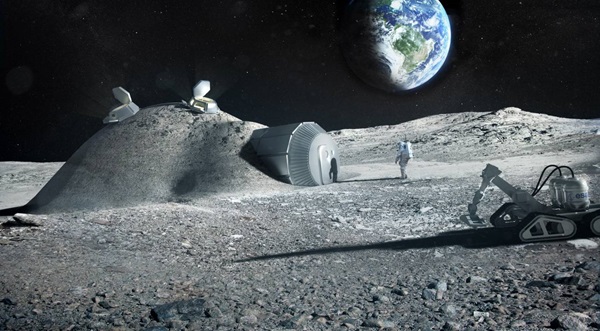Human urine could help astronauts build Moon bases — no joke – Astronomy Magazine
Moon Village, as seen in this artist’s illustration, is a concept lunar outpost that would 3D-print protective shells around inflatable habitats using lunar soil. New research shows that urea, a compound found in urine, can function as a valuable additive to such 3D-printed structures.
ESA, Foster and Partners
Shipping stuff to other worlds is expensive. We’re talking several thousand dollars per pound to get to the Moon, at best. This is why long-term plans for establishing a presence on the lunar surface — including building Moon bases — recognize that we’ll need to use any local material we can. And I mean anything. Even, apparently, urine.
European researchers have found that the second-most abundant component of urine — urea — can serve as an effective plasticizer that helps keep 3D-printed structures workable while still maintaining their strength and stability during hardening. Plasticizers are often used in geopolymers (think ceramics or simple concrete) because they make the initial mixture easier to shape while avoiding dilution with too much water, which would weaken the final product.
By combining simulated lunar soil with water and urea, the researchers made 3D-printed geopolymer cylinders that outperformed versions that didn’t include a plasticizer. The researchers also compared their urea-based samples to versions made with more common, polycarboxylate- and naphthalene-based plasticizers. The team found the urea versions could support heavy weights, largely maintain their shape, and withstand eight freeze-thaw cycles (like those lunar bases would experience) about as well as the versions made with the standard plasticizers.
“To make the geopolymer concrete that will be used on the Moon, the idea is to use what is there: regolith (loose material from the Moon’s surface) and the water from the ice present in some areas,” Ramón Pamies, an engineering professor at the Polytechnic University of Cartagena in Spain and co-author of the study, said in a press release. This geopolymer concrete would then be printed layer-by-layer to encase a crewed habitat, ideally providing protection from lunar hazards like temperature swings, harmful radiation, and micrometeorites.
“With this study, we have seen that a waste product, such as the urine of the personnel who occupy the Moon bases, could also be used,” Pamies said. “The two main components of this body fluid are water and urea.”






